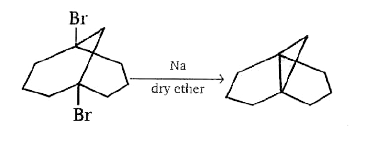Which of the following give ether as a major product -
To determine which reaction gives ether as a major product, we will analyze each of the given reactions step by step.
Step 1: Analyze the first reaction
Reaction: Ethanol (C2H5OH) treated with PCl5.
- When ethanol reacts with phosphorus pentachloride (PCl5), it undergoes a substitution reaction.
- The hydroxyl group (-OH) is replaced by a chlorine atom, resulting in the formation of ethyl chloride (C2H5Cl) and side products (POCl3 and HCl).
- Major Product: Ethyl chloride (C2H5Cl).
- Ether Formation: No ether is formed.
Step 2: Analyze the second reaction
Reaction: Ethanol (C2H5OH) treated with concentrated H2SO4 at 100-140°C.
- Concentrated sulfuric acid (H2SO4) donates a proton (H+) to the hydroxyl group of ethanol, forming a protonated ethanol (C2H5OH2+).
- A second ethanol molecule attacks the carbocation formed, leading to the formation of diethyl ether (C2H5OC2H5) after the removal of a water molecule.
- Major Product: Diethyl ether (C2H5OC2H5).
- Ether Formation: Ether is formed.
Step 3: Analyze the third reaction
Reaction: Ethyl chloride (C2H5Cl) treated with aqueous KOH.
- In this reaction, KOH acts as a nucleophile and replaces the chlorine atom with a hydroxyl group, resulting in the formation of ethanol (C2H5OH).
- Major Product: Ethanol (C2H5OH).
- Ether Formation: No ether is formed.
Step 4: Analyze the fourth reaction
Reaction: Ethene (C2H4) treated under acidic hydrolysis.
- Ethene reacts with H+ to form a carbocation (C2H5+).
- Water then attacks the carbocation, leading to the formation of ethanol (C2H5OH) after deprotonation.
- Major Product: Ethanol (C2H5OH).
- Ether Formation: No ether is formed.
Conclusion
From the analysis, the only reaction that produces ether as a major product is the second reaction where ethanol is treated with concentrated H2SO4 at 100-140°C. Therefore, the answer is:
Ether as a major product is formed in the second reaction.
---
Reaction: Ethanol (C2H5OH) treated with PCl5.
- The hydroxyl group (-OH) is replaced by a chlorine atom, resulting in the formation of ethyl chloride (C2H5Cl) and side products (POCl3 and HCl).
- Major Product: Ethyl chloride (C2H5Cl).
- Ether Formation: No ether is formed.
Reaction: Ethanol (C2H5OH) treated with concentrated H2SO4 at 100-140°C.
- A second ethanol molecule attacks the carbocation formed, leading to the formation of diethyl ether (C2H5OC2H5) after the removal of a water molecule.
- Major Product: Diethyl ether (C2H5OC2H5).
- Ether Formation: Ether is formed.
Reaction: Ethyl chloride (C2H5Cl) treated with aqueous KOH.
- Major Product: Ethanol (C2H5OH).
- Ether Formation: No ether is formed.
Reaction: Ethene (C2H4) treated under acidic hydrolysis.
- Water then attacks the carbocation, leading to the formation of ethanol (C2H5OH) after deprotonation.
- Major Product: Ethanol (C2H5OH).
- Ether Formation: No ether is formed.
From the analysis, the only reaction that produces ether as a major product is the second reaction where ethanol is treated with concentrated H2SO4 at 100-140°C. Therefore, the answer is:
Topper's Solved these Questions
Similar Questions
Knowledge Check
Which of the following does not represent major product of the reaction ?
A B
B C
C D
D
Which of the following is the major product from sulfonation of a-tetralone ?
 A
A B
B C
C D
D
Which of the following is a major product of the reaction shown below?
 A
A B
B C
C D
D
Which of the following is the major product of give reation:
_2019_CBT3_E01_002_Q01.png) overset(LiAlH_(4))rarr
overset(LiAlH_(4))rarr
View SolutionWhich of the following is the major product for the given reaction ?

View SolutionWhich of the following is the major product for the given reaction ?

View SolutionWhich of te following reaction gives correct major product-
View SolutionCis−but−2−e≠ on bromination in Cl4 gives which one of the following as a major product?
View Solution

